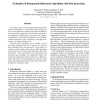Free Online Productivity Tools
i2Speak
i2Symbol
i2OCR
iTex2Img
iWeb2Print
iWeb2Shot
i2Type
iPdf2Split
iPdf2Merge
i2Bopomofo
i2Arabic
i2Style
i2Image
i2PDF
iLatex2Rtf
Sci2ools
AVSS
2008
IEEE
2008
IEEE
Evaluation of Background Subtraction Algorithms with Post-Processing
Processing a video stream to segment foreground objects from the background is a critical first step in many computer vision applications. Background subtraction (BGS) is a commonly used technique for achieving this segmentation. The popularity of BGS largely comes from its computational efficiency, which allows applications such as humancomputer interaction, video surveillance, and traffic monitoring to meet their real-time goals. Numerous BGS algorithms and a number of postprocessing techniques that aim to improve the results of these algorithms have been proposed. In this paper, we evaluate several popular, state-of-the-art BGS algorithms and examine how post-processing techniques affect their performance. Our experimental results demonstrate that post-processing techniques can significantly improve the foreground segmentation masks produced by a BGS algorithm. We provide recommendations for achieving robust foreground segmentation based on the lessons learned performing this compa...
| Added | 12 Oct 2010 |
| Updated | 12 Oct 2010 |
| Type | Conference |
| Year | 2008 |
| Where | AVSS |
| Authors | Donovan H. Parks, Sidney Fels |
Comments (0)

